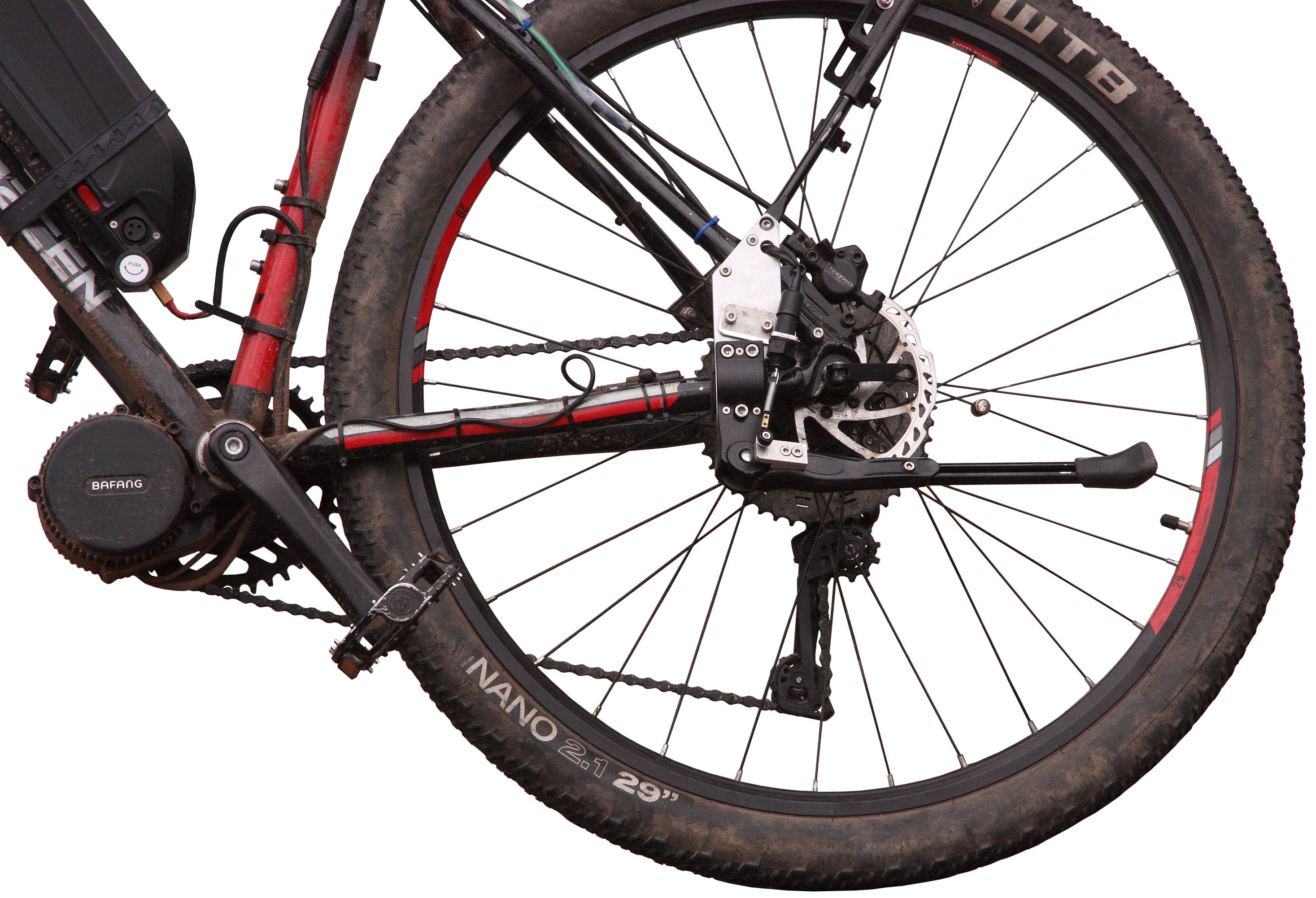 |
E-bike conversion |
E-bike Legal |
E-bike battery |
E-bike electrics |
Side stand |
Steering damper |
Electric m/c |
E-bike Side Stand Safety
Side-stands are hideously dangerous; but it is often difficult to fit a pedal bike with a centre-stand, and the presence of a mid-drive motor in the bottom bracket blocks one of the best mounting points. A side-stand is therfore usually the only practical option; and the business of remembering not to ride-off with it sticking-out depends on the terror engendered by some previous occasion of having done so. Just as modern motorcycles don't allow the engine to run with the side-stand down however; it is possible to make a safety side-stand for e-bikes by incorporating a switch to short-out one of the brake inputs and thereby disable the motor. Failure to retract the stand is then immediately obvious when pulling away, particularly if a twist & go throttle is used during initial acceleration.
Unfortunately, although some commercial e-bikes might possibly have a stand safety-switch, at time of writing (July 2020), there are no commercially-made retro-fit side-stands with such a switch. Obtaining a safety-stand therefore becomes a matter of modifying an existing stand, or making a new one, until manufacturers see fit to supply this potential market.
There are actually two main types of after-market side-stand for pedal cycles. The cheapest type simply clamps around the lower tube of the rear forks on one side, but has the tendency to rotate about the tube. This means that it requires some kind of rubber protector to prevent it from scratching the paintwork, and it will need frequent tightening and readjustment to keep it in the right position. The better type is sometimes called a 'Delta stand,' because it clamps across two frame tubes and so forms a triangular shape, like the capital Greek letter Delta.
Of the two types moreover, there is a further division depending on the method used to lock the leg in either the up or down position. One variant has a detent spring concealed within the casting (see for example the Robesbon Sidestay). The other variant has a spring and a collar around the stand leg (see for example Hebie Rear Stand 671). The external detent spring unfortunately obscures the obvious position for a switch actuator attachment..
When I first built e-bikes, I used single-clamp side-stands because I didn't know that the Δ-type existed. The stands I bought had internal detent springs however, and so were relatively easy to modify. Shown below is what I devised for the Saracen Tufftrax 29.

Stand in the 'up' position.
Switch shaft retracted (open circuit).

Stand in the 'down' position.
Switch shaft pulled out (contacts closed).

View showing how the stand clamps
around the frame tubes.
I made a mounting plate out of a length of 10×50mm aluminium bar, with milled recesses at the back to make it register positively onto the upper and lower rear-fork tubes. Thus the new arrangement has become Δ-stand. The mounting plate also replaces one of the clamps of a pannier rack, which is a permanent attachment to the bike (it carries the rear lights, and can be fitted with a pair of Ortlieb Back-Roller Classic panniers). The original inner part of the stand clamp is still used, compete with supplied rubber paint protectors, longer screws being required to allow for the additional thickness of the plate. The original stand bolt-holes are also used, but three additinal countersunk screw holes have been drilled so that the stand can be held onto the plate with M3 screws. This allows the assembly to be removed from the bike without it coming to pieces. The switch is a Honnoh 'universal' motorcycle rear brake-light switch, the same as was used for the brake levers. It is attached to a bracket screwed to the mounting plate, and connected to the stand leg by means of the supplied spring. A small block of aluminium is bolted to the stand leg and protrudes over the pivot point. This means that the end of the spring moves over a small radius as the stand is extended, thereby avoiding excessive stretching when the switch is operated. A small pillar with a top washer is screwed to the block, and the spring is wrapped around that. As was done with the brake switches, the end ot the spring is formed into a loop by means of a brass insert taken from an electrical connecting block. The original zinc-plated M3 grub screws have been replaced with stainless A4 Allen screws to prevent corrosion.
In order to incorporate a safety stand into an existing e-bike setup, the wiring required does not need to be sophisticated. A simple Higo Mini B3 Y-piece adapter would allow it to be plugged into one of the Bafang brake kill inputs, in parallel with an existing switch, without the need for any technical skill on the part of the installer.

 |
E-bike conversion |
E-bike Legal |
E-bike battery |
E-bike electrics |
Side stand |
Steering damper |
Electric m/c |
© D
W Knight 2020
Last updated
2020-Jul-19